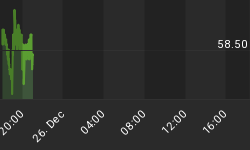Monday's decline in global equities wasn't exactly a wrenching selloff, except for one thing: it seemed to be completely unexpected. While the S&P only fell 1.2% - reversing almost every penny of that decline today - European equities was where the pain really was. The Eurostoxx 50, representing a pan-European collection of big firms such as Siemens, Volkswagen, Nokia, etc (about 25% Financials, 18% Consumer Goods, and other sectors weighted 10% or less), fell 3.1% on Monday and rebounded only 1% on Tuesday.
Don't go to sleep, Americans! We have not necessarily heard the last of the crisis in Europe!
In the U.S., stocks remain up 6% since December 31, but on Monday's close the Eurostoxx was actually down for the year. And don't blame it all on Spain's Prime Minister Rajoy and the scandals currently swirling about him; Italian 10-year bond yields are also up 30bps in the last week and a half. It isn't entirely clear where the sudden case of the jitters is coming from, but it certainly doesn't help the global economic recovery that Brent Crude is nearing $120/bbl again, up nearly 30% from the June lows realized in the teeth of the crisis.
(Incidentally, Carlo Rosa at the New York Fed just published an interesting paper that argues "monetary policy news has economically important and highly significant effects on the level and volatility of energy futures prices and trading volumes." He finds that the Fed's LSAP1 and LSAP2 programs "have a cumulative financial market impact on crude oil equivalent to an unanticipated cut in the federal funds rate of 155 basis points." I have no confirmation of the rumor that Mr. Rosa has been disinvited from the Fed's President's Day bash this year.)
Now, economic data has been weaker in January than in December, at least in the U.S., but so far at least not by as much as I thought. Still, stock markets are priced for something more than "not as bad as I thought," and having February gasoline prices at record highs (see chart, source Bloomberg) for this time of year - albeit not by much above last year's record, yet - is a buzzkill for anyone hoping for a 2013 blastoff.

It also is a buzzkill for Federal Reserve members, I am sure. While the Fed concentrates on core inflation, since it is less volatile (and better-related to 2-year forward inflation than headline inflation), consumers notice and set their expectations based on the whole consumption basket. The best possible outcome for the Fed would be that both core and headline inflation decline, while they work to juice the system. The second-best possible outcome is that core rises, but headline stays low as lower fuel prices help both growth and inflation perceptions. The absolutely worst outcome is that core rises because Fed easing is pushing asset prices (for example, in homes) higher while headline prices scream past even faster because of higher energy prices...and those higher energy prices also serve to retard growth.
One-year headline inflation swaps are currently priced at 2.03%. While core inflation is currently at 1.9%, for reasons I've cited here before that is very unlikely to persist for any length of time, and if energy prices sustain any kind of rise at all, a 2.03% headline inflation over the next year seems optimistic to me. To be fair, I should note that the gasoline futures curve is reasonably backwardated, so an easier way to make the same trade is probably to buy March 2014 gasoline futures at $2.69 compared to $3.04 for prompt March.
Although it seems all is well in the U.S. stock market, investors should be increasingly wary. I wrote last week that there are signs some markets are catching the scent of inflation; while growth in the U.S. looks okay and our stock market is riding high, let this note be a warning that other markets are catching the scent of something still stinking in Europe. Implied volatilities are still low, and this may be a good time to buy protection.















